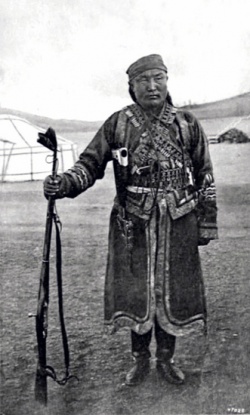Dambijantsan and his disciple Jimbe
In the early Spring of 1912 Dambijantsan and his disciple Jimbe left his Headquarters on the Dund Tsenkher Gol and traveled north to the Dörvöd Dalai Khan and the Dörvöd Zorigt Khan aimags in the the border region to the west of the four Khalkh aimags. As their names implies, these aimags, located in what is now Uvs Aimag and northern Khovd Aimag, were in large part inhabited by Dörböd, the tribe Dambijantsan supposed belonged to back in Kalmykia. While in Dörvöd Dalai Khan Aimag Dambijantsan first meet with A. V. Burdukov, the Russian trader who would become his close friend and who would write at length about him in his book Old and New Mongolia. Burdukov at time had a homestead and trading post at Khangeltsyk, near the town Tsagaan Khairkhan in current-day Uvs Aimag, northeast of Khyargas Nuur. Burdukov visited Dambijantsan in a ger where he was staying:
At first we thought that they Dambijantsan and Jimbe were just two badarchin, but people said no, they are very significant people. He was about 40–45 years old, stout, strongly built, with a round, purposeful face. He had a high forehead and bright, shining eyes. Although he was dressed as a Tibetan lama in a maroon gown with broad cuffless sleeves, he wore a well-made pair of Russian boots, and peeping out from under the gown was the collar of an old Russian military uniform. His accent was neither Khalkh nor Oirat but a mixture. Mausers were hung on the wall of the yurt. He knew much about events in Mongolia, Russia, and China. He inspired belief in him by others to an extraordinary degree. People came into his yurt and asked his blessing, which he always gave. He looked like someone born on the steppe and at the same time as an experienced agitator.
In the course of his conversations with Burdukov Dambijantsan spoke about India and Tibet, where he claimed to have traveled extensively. “There could be little doubt as to the man’s wide experiences and travel,” Burdukov noted, “his information about the countries he mentioned was remarkably precise and detailed . . . Ja Lama had a command not only of the Mongolian language, but of Chinese, Tibetan, and Sanskrit as well, and he also knew a bit of Russian.” (Oddly, the Diluv Khutagt claimed that Dambijantsan, despite the years he had supposedly lived in Tibet, could not speak Tibetan at all.) Maisky, traveling through the region a few years later when stories about Dambijantsan’s first appearance there were still in circulation, also commented on Dambijantsan’s extensive travels in India, Tibet and elsewhere: “A man who had gone through this kind of schooling [his various travels] and acquired some smattering of European culture would under any circumstances greatly impress the simple-minded Mongols . . .”
But not only was he well-traveled and supposedly well-educated, he was also the successor to Amarsanaa, a claim which he never tired of repeating. Maisky’s comments on the effects this assertion had on the locals:
One can . . . easily imagine the sensation Ja Lama created among the Durbets [Dörböds] when he let them in on the “secret” that he was none other than a descendent and reincarnation of the renowned Amursana and that the last hero of Mongolian independence had become incarnated in him so that he, Ja Lama, might lift the Chinese yoke from his native land. There was great excitement among the tribes of the Khovd region. The name of Ja Lama was on all tongues. Everyone saw him as the savior of the fatherland. Princes, lamas and plain folk came flocking to the newly-risen leader and donated livestock, silver, cloth, etc. In a short time, the bold monk became in fact the ruler of the Kobdo Mongols. He now began his activities in earnest.
Dambijantsan’s prestige in Dörvöd Dalai Khan Aimag was enhanced by all kinds of magical acts which were attributed to him. He seemed to know all the life-stories and even the most intimate secrets of all the important people in the area. People put this down to his supernatural powers of cognition and mind reading, but as Burdukov pointed out he might well have gotten this information from the gossip of the many people who were constantly coming to him for blessings. Burdukov also mentioned that at one point he took some photographs of Dambijantan. He later inadvertently re-exposed the negative containing Dambijantsan’s image when he was taking a photo of local Mongolian noblemen. When the negative was printed the faces of the Mongol princes showed up on Dambijantsan’s sleeve. Despite Burdukov’s explanations of what had happened, the Mongols who saw this photograph insisted that this was further proof of Dambijantsan’s magical powers. HIs every act took on a special significance. He frequently gave his disciple Jimbe severe beatings, but witnesses took this to mean that Jimbe was a great sinner and that Dambijantsan was performing a virtuous act by punishing him. In the eyes of many Dambijantsan could do no wrong.
